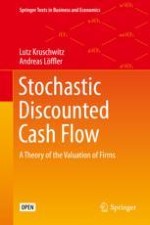7.1 Basic Elements
7.1.1 Fundamental Terms
7.1.2 Conditional Expectation
7.1.3 A First Glance at Business Values
7.2 Corporate Income Tax
7.2.1 Unlevered Firms
7.2.1.1 Basics About Levered Firms
7.2.2 Autonomous Financing
Time | Q(⋅) |
|---|---|
t = 1 | Q1(u) = 0.0833, Q1(d) = 0.9167 |
t = 2 | Q2(uu) = 0.00347, Q2(ud) = 0.07986, Q2(du) = 0.11458, Q2(dd) = 0.80208 |
t = 3 | Q3(uuu) = 0.00130, Q3(uud) = 0.00217, Q2(udu) = 0.05657, Q2(duu) = 0.08116, |
Q3(udd) = 0.02329, Q3(dud) = 0.08116, Q3(ddu) = 0.33420, Q3(ddd) = 0.46788 |
7.2.3 Financing Based on Market Values
7.2.4 Financing Based on Book Values
-
The expectation of the future book value does not depend on time. It stays constant at a level above the book value today.
-
The variance does depend on time. With higher t the variance increases, the increase is linear with slope \(\alpha \,\frac {(n+1)^2}{4}\).

